|
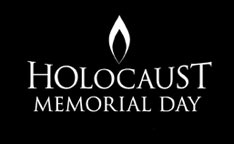 The Holocaust: The Holocaust:
Millions exterminated on Jan 27, 1945 - a grim reminder
By Pramod DE SILVA
The train arrived in the middle of the
night, so we were greeted by very bright lights shining down on us. We
were greeted by soldiers, SS men, as well as women. We were greeted by
dogs and whips, by shouting and screaming, orders to try to empty the
train, by confusion... There is no way to describe your first coming to
Auschwitz.
-Survivor Fritzie Weiss Fritzshall
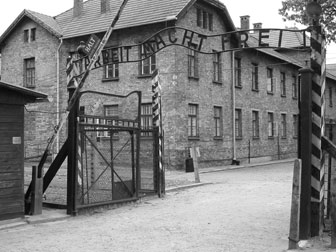 |
|
Auschwitz buildings |
So I was hiding out in the heap of dead
bodies because in the last week when the crematoria didn't function at
all, the bodies were just building up higher and higher. So there I was
at nighttime, in the daytime I was roaming around in the camp, and this
is where I actually survived. I was one of the very first, Birkenau was
one of the very first camps being liberated. This was my survival
chance.
- Survivor Bart Stern
"... in spite of everything, I still believe
that people are really good at heart. I simply can't build up my hopes
on a foundation consisting of confusion, misery, and death. I see the
world gradually being turned into a wilderness, I hear the ever
approaching thunder, which will destroy us too, I can feel the
sufferings of millions and yet, if I look up into the heavens, I think
that it will all come right, that this cruelty too will end, and that
peace and tranquillity will return again."
- Anne Frank
A couple of months back, I watched a remarkable film called The Boy
in the Striped Pyjamas on DVD. The film portrayed a moving story about
one of the most shameful and horrendous episodes in human history,
through the eyes of an eight-year-old boy, the son of a Nazi official.
The innocent boy does not know what goes on inside the big building just
a kilometre or so away from his home in Auschwitz. When he eventually
discovers what actually happens there, it is too late for him and
everyone else.
Yes, the whole world was too late to realise the gravity of Adolf
Hitler's ambitions. It took a world war and millions of deaths to defeat
his ideology of creating a pure Aryan State and dominating the globe. He
perpetrated the biggest crime against humanity in this process - the
extermination of millions of innocent people - especially Jews - in
concentration camps built especially for one purpose - gassing people to
death. The carnage was so unimaginable that no existing word could
describe it - a new term "Holocaust" came into being.
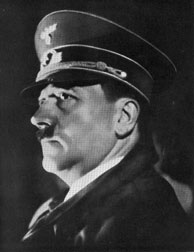 |
|
Adolf Hitler |
The Holocaust was the systematic, bureaucratic, State-sponsored
persecution and murder of six million Jews by the Nazi regime and its
collaborators. "Holocaust" is a word of Greek origin meaning "sacrifice
by fire." The Nazis, who came to power in Germany in January 1933,
believed that Germans were "racially superior" and that the Jews, deemed
"inferior," were an alien threat. This was the basis for the genocide of
members of the Jewish community.
Nazi policy
In 1933, the Jewish population of Europe stood at over nine million.
By 1945, Nazi rulers had killed two out of every three European Jews as
part of the Final Solution, the official Nazi policy to murder the Jews
of Europe in concentration camps and elsewhere. German SS and police
units, supported by units of the Wehrmacht and the Waffen SS, murdered
more than a million Jewish men, women, and children, and hundreds of
thousands of others.
In the final months of the war, SS guards moved camp inmates by train
or on forced marches, often called "death marches," in an attempt to
prevent the Allied liberation of large numbers of prisoners. The marches
continued until May 7, 1945, the day the German armed forces surrendered
unconditionally to the Allies.
German authorities also targeted other groups because of their
perceived "racial inferiority": Gypsies, the disabled, and Slavic
peoples. Other groups were persecuted on political, ideological, and
behavioural grounds, among them Communists, Socialists and homosexuals.
In the eyes of Hitler, they all deserved the gas chamber.
Between 1941 and 1944, Nazi German authorities deported millions of
Jews from Germany, from occupied territories, and from the countries of
its Axis allies to ghettos and to extermination camps, where they were
murdered in especially developed gas chambers.
This is a horror that the world can never forget. Every year, on
January 27, people around the world commemorate the greatest human
tragedy ever. The International Holocaust Remembrance Day is a day to
reflect on one of the darkest periods in contemporary history and mourn
the millions of victims. But why January 27?
Educational programs
It was on January 27, 1945 that Soviet troops liberated the largest
and most infamous concentration camp of them all - Auschwitz Birkenau.
In 2005, the United Nations General Assembly designated this day as
International Holocaust Remembrance Day (IHRD), an annual day of
commemoration to honour the victims of the Nazi era. Every member nation
of the UN has an obligation to honour the memory of Holocaust victims
and develop educational programs as part of an international resolve to
help prevent future acts of genocide. The UN resolution that created the
IHRD rejects denial of the Holocaust, and condemns discrimination and
violence based on religion or ethnicity.
Located 37 miles west of Krakow (Cracow), near the pre-war
German-Polish border, Auschwitz was the largest camp established by the
Germans. A complex of camps, Auschwitz included a concentration,
extermination, and forced-labour camp. The Soviet army liberated more
than 7,000 remaining Auschwitz prisoners, who were mostly ill and dying.
It is estimated that at least 1.3 million people were deported to
Auschwitz between 1940 and 1945 and at least 1.1 million of them were
murdered. Treblinka was another well-known camp in Poland where Jews
were massacred.
In mid-January 1945, as Soviet forces approached the Auschwitz camp
complex, the SS began evacuating Auschwitz and its satellite camps.
Nearly 60,000 prisoners were forced to march west from the Auschwitz
camp system. Thousands had been killed in the camps in the days before
these death marches began. Tens of thousands of prisoners, mostly Jews,
were forced to march to the city of Wodzislaw in the western part of
Upper Silesia.
SS guards shot anyone who fell behind or could not continue.
Prisoners also suffered from the cold weather, starvation, and exposure
on these marches. More than 15,000 died during the death marches from
Auschwitz. A new book, launched this week, claims that some brainwashed
German civilians too killed these death march inmates. 'The Death
Marches: The Final Phase Of Nazi Genocide' by Daniel Blatman of the
Hebrew University in Jerusalem is the first book to reveal this fact
obscured by history.
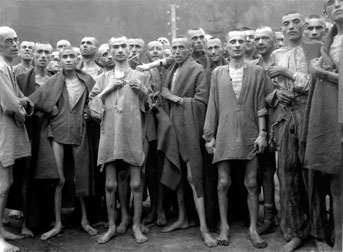 |
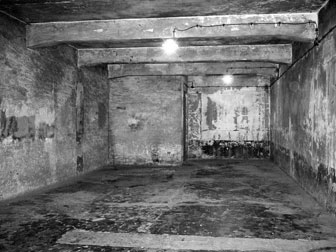 |
|
Auschwitz inmates
A gas chamber at Auschwitz |
In the aftermath of the Holocaust, many of the survivors found
shelter in camps established and administered by the Allied powers.
Between 1948 and 1951, almost 700,000 Jews emigrated to Israel,
including 136,000 Jewish displaced persons from Europe. Other Jewish
displaced persons emigrated to the United States and other nations. The
last such camp was closed in 1957. The crimes committed during the
Holocaust devastated most European Jewish communities and entirely
eliminated hundreds of Jewish communities in occupied eastern Europe.
Nuremburg Trial
Following World War II, governments and individuals such as Simon
Wiesenthal, a survivor of an extermination camp, began hunting Nazi
officials directly responsible for the genocide of Jews. Many Nazi
leaders (apart from Adolf Hitler, Heinrich Himmler and Josef Goebbels
who had committed suicide) were tried at Nuremberg. The first and best
known of these trials was the Trial of the Major War Criminals before
the International Military Tribunal (IMT), which tried 22 of the most
important captured leaders of Nazi Germany. The initial trials were held
from November 20, 1945 to October 1, 1946. The most high profile Nazi
leaders to be tried were Martin Bormann (in absentia - he had committed
suicide, though the Allies did not know it at the time) and Herman
Goring. Ten of the Nazi leaders were executed on October 16, 1946.
However, many Nazi leaders had escaped to various countries, mainly in
South America. Wiesenthal and several others dedicated their lives to
tracking them down and bringing them before the law.
Simon Wiesenthal dedicated his life to documenting the crimes of the
Holocaust and hunting down the perpetrators still at large. "When
history looks back," Wiesenthal explained, "I want people to know the
Nazis weren't able to kill millions of people and get away with it."
As founder and head of the Jewish Documentation Center in Vienna, the
freelance Nazi hunter, usually with the cooperation of the Israeli,
Austrian, former West German and other governments, ferreted out nearly
1,100 Nazi war criminals, including Adolf Eichmann, the administrator of
the slaughter of the Jews; Franz Murer, "The Butcher of Wilno," and
Erich Rajakowitsch, in charge of the "death transports" in Holland.
Eichmann was captured in Argentina, brought to Israel and executed in
1961. Sadly, there are many more Nazi officials who were never caught
and could still be living free.
But no one can forget the massive carnage they caused. The memory of
their victims will never fade away. The main commemoration ceremonies
this year will be held at the United Nations headquarters in New York,
the highlight being the exhibition 'The Memories Live On' comprising
drawings of Auschwitz made by an unknown prisoner of the concentration
camp, focusing on the legacy of the survivors to young people. Memorial
events will be held around the world.
Even if you cannot go to any of these events, just light a candle for
the millions of Holocaust victims who were killed mercilessly for no
fault of theirs.
|

